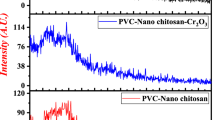Abstract
The Ni/C/NiO composite thin films have been prepared by one-step sol–gel method. The prepared samples were annealed at 450 °C with different holding times. When the metallic nickel nanoparticles were homogeneously dispersed in the composite, it is observed that both NiO and metallic Ni are surrounded by resident carbon. Comprehensive analysis techniques have been carried out in order to analyze the structural, optical, and solar- selective absorber properties of the composite. The main structure variations with various holding times are (i) the decrease in thickness and (ii) enhancement of metallic Ni nanoparticles size. The solar-selective absorber properties for one-layer Ni/C/NiO composite film annealed at 450 °C with 10 min of holding time show the optimal performance in the present work, exhibiting an absorbance of about 0.80 and an emittance of about 0.11, and capable of a good candidate as SSA for the low–middle temperature applications.










Similar content being viewed by others
References
Wang ZY, Yang WS, Qiu F, Zhang XM, Zhao XD (2015) Solar water heating: from theory, application, marketing and research. Renew Sust Energ Rev 41:68–84
Li PF et al. (2015) Large-scale nanophotonic solar selective absorbers for high-efficiency solar thermal energy conversion. Adv Mater 27(31):4585–4591
Khodasevych IE, Wang LP, Mitchell A, Rosengarten G (2015) Micro- and nanostructured surfaces for selective solar absorption. Adv Opt Mater 3(7):852–881
Avila-Garcia A, Morales-Ortiz U (2006) Thermally and air-plasma-oxidized titanium and stainless steel plates as solar selective absorber. Sol Energy Mater Sol Cells 90:2556–2568
Zhao S, Wackelgard E (2006) Optimization of solar absorbing three-layer coatings. Sol Energy Mater Sol Cells 90:243–263
Konttinen P, Lund PD, Kilpi RJ (2003) Mechanically manufactured selective solar absorber surfaces. Sol Energy Mater Sol Cells 79:273–283
Orel ZC (1999) Characterization of high-temperature-resistant spectrally selective paints for solar absorbers. Sol Energy Mater Sol Cells 57:291–301
Niklasson GA, Granqvist CG (1984) Optical properties and solar selectivity of coevaporated Co-Al2O3. J Appl Phys 55:3382–3410
Reza Nejati M, Fathollahi V, Khalaji Asadi M (2005) Computer simulation of the optical properties of high-temperature cermet solar selective coatings. Sol Energy 78:235–241
Katzen D, Levy E, Mastai Y (2005) Thin films of silica-carbon nanocomposite for selective solar absorber. Appl Surf Sci 248:514–517
Wang D, Xu R, Wang X, Li Y (2006) NiO nanorings and their unexpected catalytic property for CO oxidation. Nanotechnology 17:979–983
He J, Lindstrom H, Hagfeldt A, Lindquist S (1999) Dye-sensitized nanostructured p-type nickel oxide film as a photocathode for a solar cell. J Phys Chem B 103:8940–8943
Yue Z et al. (2010) Detection of CO2 in solution with pt—NiO solidstate sensor. J Colloid Interface Sci 348:227–231
Uplane MM et al. (2007) Structural, optical and electrochromic properties of nickel oxide thin films grown for electrodeposited nickel sulphide. Appl Surf Sci 253:9365–9371
Chopra N, Shi W, Bansal A (2011) Structural evolution and stability studies of heterostructures comprised of carbon nanotubes decorated with nickel/nickel oxide core/shell nanoparticles. Carbon 49:3645–3662
Lota K, Sierczynska A, Lota G (2011) Supercapacitor based on nickel oxide/carbon materials composites. Int J Electrochem 2011:6
Chang HC et al. (2012) Preparation and electrochemical characterization of NiO nanostructure-carbon nanowall composites grown on carbon cloth. Appl Surf Sci 258:8599–8602
Xia Y et al. (2012) Biotemplated fabrication of hierarchically porous NiO/C composite from lotus pollen grains for lithium-ion batteries. J Mater Chem 22:9209–9215
Li H, Li Y, Wang R, Cao R (2009) Synthesis and electrochemical capacitor performance of mesostructured nickel oxide/carbon composites by a co-casting method. J Alloy Compd 481:100–105
Amri A et al. (2014) Developments in the synthesis of flat plate solar selective absorber materials via sol–gel methods: a review. Renew Sust Energ Rev 36:316–328
Mastai Y, Polarz S, Antonietti M (2002) Silica-carbon nanocomposites: a new concept for the design of solar absorbers. Adv Funct Mater 12(3):197–202
Katzen D, Levy E, Mastai Y (2005) Thin films of silica–carbon nanocomposites for selective solar absorbers. Appl Surf Sci 248(1–4):514–517
Katumba G et al. (2008) Solar selective absorber functionality of carbon nanoparticles embedded in SiO2, ZnO and NiO matrices. Phys Status Solidi (C) 5(2):549–551
Katumba G et al. (2008) Optical, thermal and structural characteristics of carbon nanoparticles embedded in ZnO and NiO as selective solar absorbers. Sol Energy Mater Sol Cells 92(10):1285–1292
Roro KT et al. (2012) Solar absorption and thermal emission properties of multiwall carbon nanotube/nickel oxide nanocomposite thin films synthesized by sol–gel process. Mater Sci Eng: B 177(8):581–587
Zhao SX, Ribbing CG, Wackelgard E (2004) Optical constants of sputtered Ni/NiO solar absorber film-depth-profiled characterization. Sol Energy Mater Sol Cells 84(1–4):193–203
Wang X et al. (2012) High-performance solution-processed plasmonic Ni nanochain-Al2O3 selective solar thermal absorbers. Appl Phys Lett 101(20):203109
Klochko NP et al. (2015) Zinc oxide-nickel cermet selective coatings obtained by sequential electrodeposition. Sol Energy 117:1–9
Farooq M, Green AA, Hutchins MG (1998) High performance sputtered Ni: SiO2 composite solar absorber surfaces. Sol Energy Mater Sol Cells 54(1–4):67–73
Jena A, Munichandraiah N, Shivashankar SA (2013) Carbonaceous nickel oxide nano-composites: as electrode materials in electrochemical capacitor applications. J Power Sources 237:156–166
Acknowledgements
This work was financially supported by the National Key Research and Development Program of China (No. 2016YFB0303900), National Natural Science Foundation of China (No. 51672242), and Zhejiang Provincial Natural Science Foundation of China (No. LY16E020002).
Author information
Authors and Affiliations
Corresponding authors
Ethics declarations
Conflict of interest
The authors declare that they have no conflict of interest.
Additional information
Highlights:
-
1.
A facile one-step sol–gel method is proposed to prepare C/Ni/NiO composited coatings as a solar-selective absorber;
-
2.
The metallic nickel nanoparticles homogeneously dispersed in the composite with the size ranging from 11 to 13.5 nm were observed and surrounded by resident carbon;
-
3.
High absorbance and low emissivity are achieved by a one-layer Ni/C/NiO film, as well as excellent environmental tolerance.
Rights and permissions
About this article
Cite this article
Khan, S., Wu, Z., ul haq, M. et al. Study of annealing effect upon the structural and solar- selective properties of C/Ni/NiO composite coatings prepared by sol–gel method. J Sol-Gel Sci Technol 89, 120–127 (2019). https://doi.org/10.1007/s10971-018-4585-2
Received:
Accepted:
Published:
Issue Date:
DOI: https://doi.org/10.1007/s10971-018-4585-2




